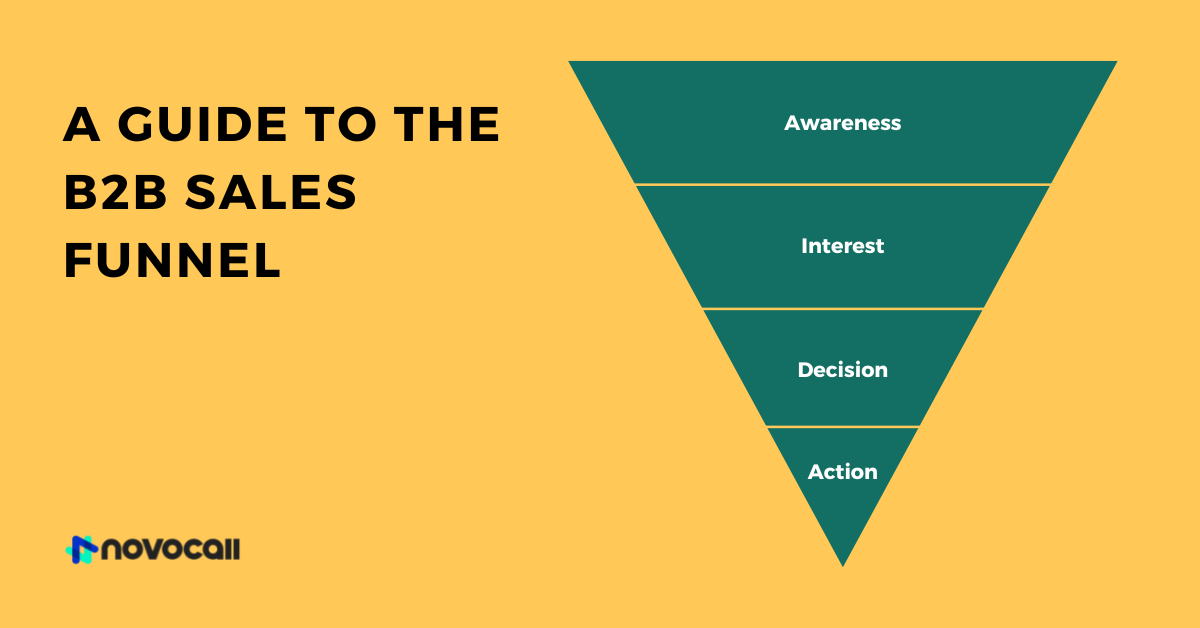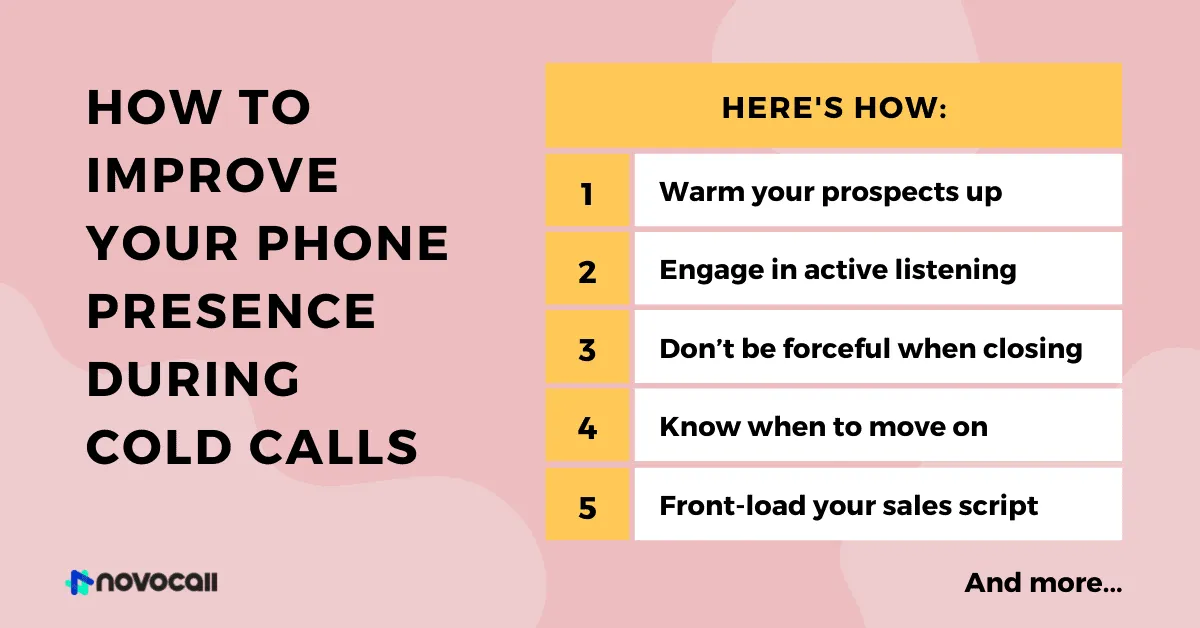


Start driving better conversations.
Novocall will be your new favorite business phone system.

Cold calling is the most commonly known outbound call method. Although many people deem cold calls ‘dead’, that is far from the case!
Statistics show that businesses that don’t cold call experience 42% less growth than those that do. Additionally, 49% of buyers actually prefer a cold call as a first point of contact.
These statistics have led many businesses to reinvest in cold calling, as the potential benefits outweigh the awkward conversations and dial tones. For those working in telemarketing, a strong phone presence will help you get through awkward pauses and will improve your conversion rate.
Here are a few tips you can use if you’re new to cold calling or are looking to improve your skills. Let’s dive right in!
Warming a prospect up before you call them will help you get past some of the most common cold calling objections — namely, “I don’t know you!”.
You can warm up a lead by sending them an introductory email a few hours before you plan to call. This technically changes them from a “cold” lead to a “warm” lead and should be a part of your every day cold calling practice.
Of course, this approach will take extra time, but you can follow a basic template that includes the following:
Ideally, your prospect will choose to schedule a call with you. This immediately turns your prospect from “cold to “hot” and will lead to a more natural conversation at a later time.
If you’re used to calling warm leads, you might find it hard to get through the first 10 to 15 seconds of a cold call.
That’s because many prospects are used to spam robot-callers and will hang up if they don’t hear any personalized information early on in the call.
To overcome this, you need to front-load your sales script and should make it clear that you are a living, caring human within the first 10 seconds.
To do this, you should consider editing your script to include the following:
By front-loading your sales pitch with personalized information, you’ll increase your chance of securing a lengthier conversation with your prospect. This gives you the opportunity to go into more detail about how your product or service can benefit and add value to their business.
So you’ve got them on the phone — now what?
The next step to improving your cold call presence is all about bringing your in-depth research on your prospect into the conversation.
You need to use any background information you have on a lead to personalize your approach. This will improve the buy-in from prospects and will make it sound as though you’ve dedicated time and effort to solve their problems.
Personalizing the call will look different depending on the industry and location you work in, but here are a few things to consider:
You can also weave an effective data strategy into your personalization technique. To do this, you’ll want to focus on finding human-centered insights that are likely to generate meaningful conversation starters — this is particularly true in B2B calling, where you can use data to talk about market trends.
When done right, personalizing your call can boost your phone presence and will make your prospect forget that the conversation started with a cold call.
At some point, you might have to ditch your script and start engaging with the prospect depending on how the conversation flows.
The best way to exit your script is to engage in active listening. Active listening allows your prospect to start engaging with the call and gives you access to a wealth of important information that should be recorded clearly on your CRM for any follow-up calls.
The way you actively listen also depends on the context of your industry.
For example, active listening in B2B requires you to use all of your market knowledge to ask questions and gather information about your prospect’s position in that market. This will help you find out if they’re a good fit for your business and will help you flaunt some of the credible industry knowledge you’ve gathered.
Active listening when selling to consumers is a little different. Consumers will often jump track during your call and will start to shift the conversation away from your product/service. This means your questions have to be a little pointed, as you cannot afford to waste time listening to a consumer’s life problems unless you plan to use that information during your pitch.
Effective active listening will help you build rapport, give you a stronger phone presence, and might give you the information you need to successfully pitch your product or service.
If you’ve been working in sales for a while, it becomes extremely tempting to follow the same pitch day in and day out.
However, this is one of the biggest telesales mistakes you can make because your prospect will realize that you have entered ‘pitch mode’ and are likely to ‘switch off’ and be disinterested in what you have to say.
You can keep the client engaged by asking questions while you pitch, and by finding ways to make them say ‘yes’.
You can start with small ‘yes’ answers first like confirming their location or need, and should work up to a larger ‘yes’ questions that lines you up to close.
For example, if you’re working in real estate, the ‘three yes’ model might look something like this:
1. So, you’re looking for a 3 bedroom property — is that correct?
2. And you have a budget of “X”?
3. Great, well I can get you booked in for a viewing next week — how does that sound?
Getting your prospect to agree with you warms them up and proves that you’ve taken their thoughts and opinions into account before you start to pitch a product or service.
Closing a sale that started with a cold call is nerve-wrecking — but it’s also extremely rewarding.
As a salesperson, the close is all about gracefully moving from the pitch towards the sale.
If this were a warm or hot lead, you could easily tell the prospect what to do and how to go about purchasing your product or service — but things are a little different when cold calling.
You have to remember that your prospect has just ‘met’ you and that they had no intention of buying whatever it is that you’re selling before the call. You don’t want to come off as pushy or forceful in selling your product or service.
The key here is to be gentle while still offering the chance of a lucrative one-call-sale.
For example, if you’re selling an educational course, you might state something like this:
“Well, it’s great to hear you’re excited about ‘X’. It sounds like you are ready to get started. I can send you an email to give you a chance to look through it in your own time, or I can just enroll you over the phone now?”
See how it carries a positive tone, reassures the lead, and gives them an option to sign up?
Part of building a successful phone presence is about knowing when to move on.
It sounds bizarre, but anyone who has worked in sales knows that some prospects are extremely unlikely to convert, but still want to talk at length about your business or service. These kinds of calls are frustrating, but you have to move on from them to maintain a balance between call volume and call time.
You can lead these conversations to a natural conclusion by trying to close the sale. Even if you know the client isn’t going to take you up on your offer today, you can push them towards booking a further offer like a webinar or product demo. This will give you a natural way to end the conversation and will ensure you don’t offend the prospect who might convert sometime in the future.
Cold calling is hard at the best of times — it’s even more difficult if you’re working on a hostile sales floor.
The best way to overcome this is to take a collaborative approach to improve your phone presence. You can do this by sharing insights and tips on what has worked for you during your cold calls with your team.
Taking the lead on collaboration might feel a little awkward at first, but you can see it as a great opportunity to improve your leadership skills. This will give you the skills you need to move into management positions, and will likely transfer well onto your calls where you might need to actively take the lead in the conversation.
Here are a couple of leadership tips to invigorate collaboration on your sales floor:
You can even get like-minded employees to commit to SMART goals as a way to create buy-in and create a sense of togetherness on your sales floor.
And there you have it! We hope that these 8 tips will help you improve your phone presence during nerve-wrecking cold calls.
Developing a strong phone presence is so much more than just confidence. You have to do your due-diligence and research your leads, engage in active listening to create rapport with your prospects, and share key insights you’ve gathered with your peers to find the best way to connect with prospects.

Ainsley Lawrence is a freelance writer with an interest in balanced living through education and technology. She loves traveling to beautiful places and is frequently lost in a good book.
Related articles
Subscribe to our blog
Get insights & actionable advice read by thousands of professionals every week.

